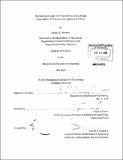| dc.contributor.advisor | Franz S. Hover. | en_US |
| dc.contributor.author | Sharples, Rachel E | en_US |
| dc.contributor.other | Massachusetts Institute of Technology. Dept. of Mechanical Engineering. | en_US |
| dc.date.accessioned | 2010-11-08T17:45:58Z | |
| dc.date.available | 2010-11-08T17:45:58Z | |
| dc.date.copyright | 2010 | en_US |
| dc.date.issued | 2010 | en_US |
| dc.identifier.uri | http://hdl.handle.net/1721.1/59921 | |
| dc.description | Thesis (S.B.)--Massachusetts Institute of Technology, Dept. of Mechanical Engineering, 2010. | en_US |
| dc.description | Cataloged from PDF version of thesis. | en_US |
| dc.description | Includes bibliographical references (p. 40). | en_US |
| dc.description.abstract | Reverse engineering is the process of determining how a system works to aid duplication, maintenance, or redesign. Applications of reverse engineering include mechanical, electrical, software, and process systems. Although it has been known for centuries in the vernacular as tinkering with things to see how they work, reverse engineering has only recently been recognized as a systematic process valid for study. Reverse engineering can be applied to both simple and complex systems. The MIT ORCA team applied reverse engineering to build ORCA XI, the first autonomous underwater vehicle (AUV) to issue forth from the ORCA Project in several years. In addition to college-level systems, reverse engineering can be applied to navies, aiding in the prototyping of individual vessels as well as the manufacturing of entire fleets. There is evidence that China is using reverse engineering in this manner to develop a regionally-capable navy. The effectiveness of reverse engineering on the ORCA Project is compared to that of the Chinese navy to determine how a reverse engineering method could be expected to scale from a simple system to a more complex one. To quantify the relationship between the complexity of the system and how effective reverse engineering that system is, a reverse engineering efficiency based on the time necessary to complete a project with reverse engineering and the time necessary to complete the same project without reverse engineering was used. The efficiency values obtained from this comparison show that applying reverse engineering to an AUV can be just as effective as applying reverse engineering to a naval vessel, but that designing the production line necessary to manufacture a fleet of vessels decreases the efficiency of reverse engineering. These results suggest that new reverse engineering methodologies can be tested for efficiency on simple prototypes before being applied to time-consuming, complex projects. | en_US |
| dc.format.extent | 43 p. | en_US |
| dc.language.iso | eng | en_US |
| dc.publisher | Massachusetts Institute of Technology | en_US |
| dc.rights | M.I.T. theses are protected by
copyright. They may be viewed from this source for any purpose, but
reproduction or distribution in any format is prohibited without written
permission. See provided URL for inquiries about permission. | en_US |
| dc.rights.uri | http://dspace.mit.edu/handle/1721.1/7582 | en_US |
| dc.subject | Mechanical Engineering. | en_US |
| dc.title | The efficiency of reverse engineering in the design of the ORCA XI autonomous underwater vehicle by Rachel E. Sharples. | en_US |
| dc.type | Thesis | en_US |
| dc.description.degree | S.B. | en_US |
| dc.contributor.department | Massachusetts Institute of Technology. Department of Mechanical Engineering | |
| dc.identifier.oclc | 676698742 | en_US |
